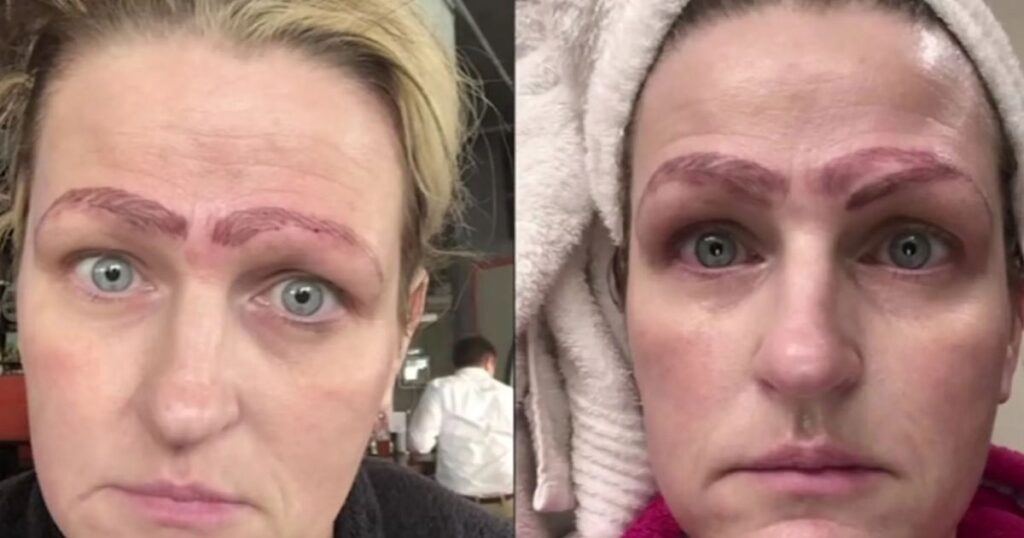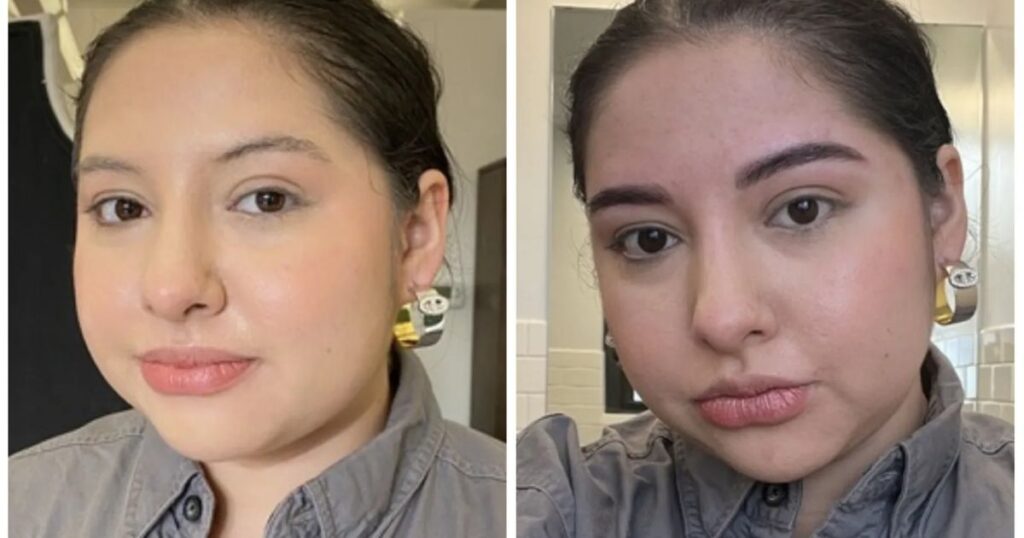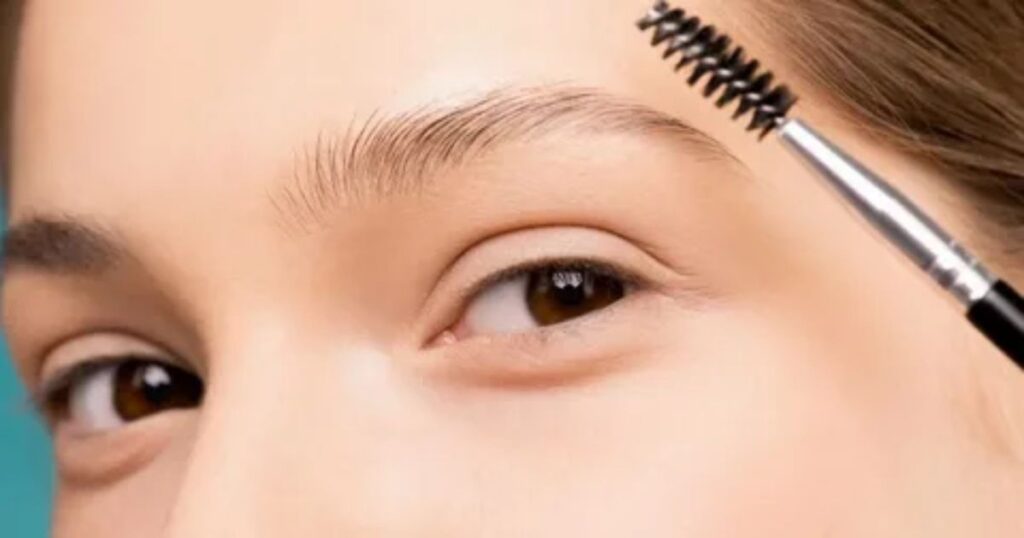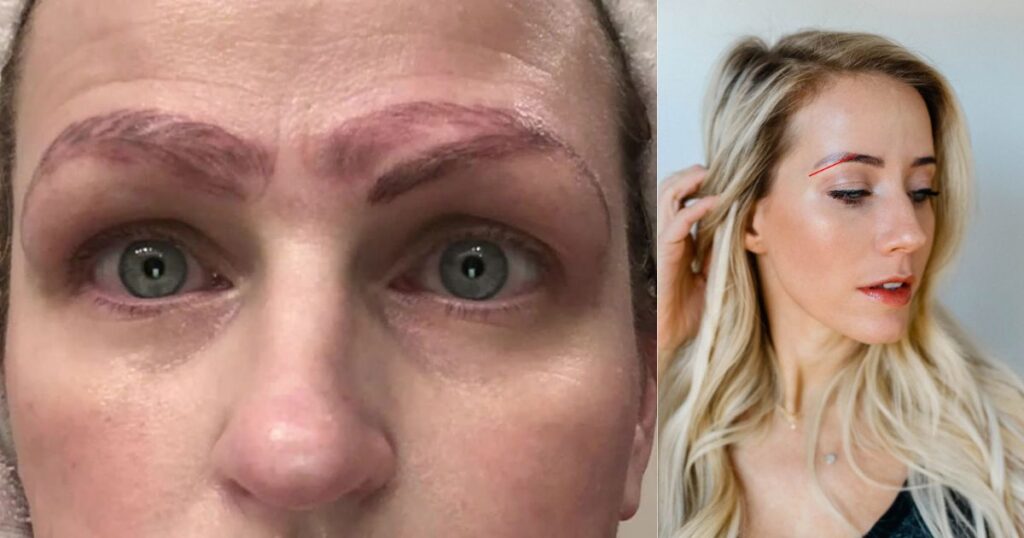Fixing microblading gone wrong is essential for restoring confidence. Microblading, a semi-permanent eyebrow tattooing technique aims to enhance eyebrows’ appearance. However, sometimes the results can be less than desirable. Uneven shapes, wrong color choices or overly bold strokes can leave you feeling self-conscious. But worry not solutions exist to rectify these mishaps.
One option is corrective microblading, a process that adjusts the shape, color and overall look of previously micro bladed eyebrows. Another solution is laser tattoo removal which can fade or completely remove unwanted pigment. Additionally, camouflage makeup can effectively conceal imperfections until they fade naturally or are corrected. Seeking a reputable and experienced professional is crucial for successful corrections.
Before proceeding, consult with a trained specialist to discuss your concerns and explore the best course of action. Remember, mistakes happen but with the right approach you can reclaim your confidence and enjoy beautifully enhanced eyebrows once again. Whether it’s a shape mishap or an unfortunate color choice there are quick and effective solutions available to fix microblading gone wrong.
Understanding Bad Microblading Eyebrows

It is crucial for correction. Microblading is a semi-permanent eyebrow tattooing technique. Sometimes, results don’t meet expectations due to various reasons. Uneven shapes or wrong color choices can occur. Overly bold strokes might look unnatural or overwhelming.
However, solutions exist to fix these issues. Corrective microblading adjusts shape, color and overall appearance. Laser tattoo removal fades or removes unwanted pigment effectively. Consulting a trained professional is vital for successful corrections. With the right approach, you can regain confidence.
Signs of Bad Microblading Eyebrows
Signs of bad microblading eyebrows are important to recognize. Uneven shapes may be noticeable immediately after the procedure. Incorrect color choices can clash with natural hair color. Overly bold strokes may look harsh and unnatural. Poorly defined arches can distort facial symmetry.
Uneven pigment distribution creates an unbalanced appearance. Scarring or skin damage may occur from improper technique. Excessive redness or swelling indicates potential issues. Consulting a professional can help address these concerns.
Common Microblading Mistakes
Common microblading mistakes can impact eyebrow appearance negatively. Uneven shaping may result in asymmetrical eyebrows. Incorrect pigment selection can lead to unnatural coloration. Overly aggressive strokes can cause scarring or skin damage. Inadequate numbing may cause discomfort during the procedure.
Poor aftercare can affect healing and final results. Inexperienced technicians may lack precision and expertise. Consultation with a skilled professional is essential. Addressing mistakes promptly ensures satisfactory outcomes.
Fixing Bad Microblading Eyebrows
Fixing bad microblading eyebrows is achievable with proper care. Corrective microblading can adjust shape, color and symmetry. Laser tattoo removal helps fade or remove unwanted pigment. Camouflage makeup conceals imperfections until corrections are made.
Seeking guidance from a skilled professional is essential. Consultation ensures the best approach for correction. Patience is key during the correction process. Results can restore confidence and enhance facial features.
Options for Fixing Bad Microblading Eyebrows
Options for fixing bad microblading eyebrows offer solutions. Corrective microblading adjusts shape, color and overall appearance. Laser tattoo removal fades or removes unwanted pigment effectively. Camouflage makeup conceals imperfections temporarily for quick fixes.
Consulting with a skilled professional ensures the best approach. Assessing the condition helps determine the most suitable option. Each method has its benefits and considerations. Restoring natural-looking eyebrows boosts confidence and satisfaction.
Correcting Botched Microblading
Correcting botched microblading requires careful consideration and action. Professional correction services can adjust shape color and symmetry. Laser tattoo removal effectively fades or removes unwanted pigment.
Camouflage makeup offers temporary coverage for immediate improvement. Consultation with a skilled technician is essential for successful correction. Each case is unique and may require a tailored approach. Patience is important during the correction process for optimal results. Restoring natural-looking eyebrows can boost confidence and satisfaction.
Correcting Eyebrow Shape
Correcting eyebrow shape enhances facial symmetry and appearance. Professional services offer precise shaping techniques for desired results. Tweezing or waxing can adjust eyebrow arches and contours. Microblading can fill in sparse areas for fuller brows.
Makeup can temporarily alter eyebrow shape for immediate changes. Consultation with a trained technician ensures personalized solutions. Each individual’s face shape influences the ideal eyebrow shape. Achieving balanced brows enhances overall facial harmony and beauty.
The Color Correction Process
The color correction process adjusts eyebrow pigment effectively. Professional technicians assess current pigment and desired outcome. Corrective techniques include pigment removal and color adjustment. Laser treatments can fade or remove unwanted pigment. Camouflage makeup provides temporary coverage for immediate improvement.
Consulting with an experienced technician ensures tailored solutions. Results depend on factors like skin tone and original pigment. Multiple sessions may be needed for optimal results. Achieving natural-looking eyebrow color enhances overall appearance.
Choosing the Right Technician for Bad Microblading Correction
Choosing the right technician for bad micro blading correction is crucial for satisfactory results.
Here’s what to consider:
- Research technicians extensively to assess their qualifications and experience.
- Look for technicians who specialize in corrective micro blading procedures.
- Read reviews and view before-and-after photos of their previous work.
- Schedule consultations with multiple technicians to discuss your concerns and expectations.
- Trust your instincts and choose a technician you feel comfortable with.
When selecting a technician for bad micro blading correction, consider the following:
- Ensure the technician is certified and trained in corrective techniques.
- Discuss your specific concerns and desired outcome during the consultation.
- Ask about the technician’s approach to correction and the expected timeline.
- Inquire about the technician’s experience with similar cases and their success rate.
- Clarify any doubts or questions you may have before proceeding with the correction.
Considering Removal Options for Bad Microblading Eyebrows
Considering removal options for bad microblading eyebrows is essential. Removal methods include laser treatments and manual techniques. Laser treatments effectively fade or remove unwanted pigment. Manual techniques involve using saline solution to lift pigment.
Consultation with a professional is crucial for assessment. Results vary depending on the individual’s skin and pigment. Multiple sessions may be necessary for complete removal. Understanding the process and potential outcomes is important. Choose a reputable technician for safe and effective removal.
Laser Removal Techniques
It effectively fade or remove unwanted pigment from the skin. Laser treatment is a common method used for microblading pigment removal. The procedure involves using a specialized laser device to target and break down the pigment particles.
Here are some key points about laser removal techniques:
- Laser removal works by emitting high-intensity light pulses that target pigment.
- The light energy is absorbed by the pigment, causing it to fragment.
- Over time, the fragmented pigment is naturally eliminated by the body.
- Multiple sessions are usually required to achieve desired results.
- The number of sessions depends on factors such as pigment depth and skin type.
- Laser removal is considered safe when performed by a trained professional.
- Side effects may include temporary redness, swelling or discomfort.
Aftercare instructions, such as avoiding sun exposure are important for optimal results.
Saline Lightening Method
The saline lightening method is a non-laser technique. It involves tattooing a saline solution into the skin. The saline solution lifts pigment out of the skin. Over several sessions, the pigment gradually fades. This method is less invasive than laser treatments. It’s suitable for sensitive skin types.
Results depend on individual skin characteristics. Multiple sessions may be needed for desired results. Side effects are typically minimal, such as mild swelling. Consultation with a trained professional is important. Aftercare instructions should be followed for optimal results.
Surgical Excision Prospects
Surgical excision is a method used to remove unwanted pigment. This procedure involves cutting out the pigmented skin tissue.
Here are some key points about surgical excision prospects:
- Surgical excision is often considered for smaller areas of pigmentation.
- It’s particularly effective for deeply embedded or stubborn pigment.
- The procedure is typically performed under local anesthesia.
- A scalpel is used to carefully remove the pigmented skin.
- The wound is then closed with sutures or stitches.
- Results are immediate, but scarring may occur.
- Proper aftercare is essential for healing and minimizing scarring.
- Surgical excision may be more costly than other methods.
- Consultation with a dermatologist or plastic surgeon is recommended.
- Patients should weigh the benefits and risks before proceeding.
The Importance of Skin Assessment in Microblading
Skin assessment in microblading is crucial for successful results. It determines skin type, texture and overall condition. Assessing skin helps identify any potential issues or concerns. Certain skin conditions may affect microblading outcomes. Understanding skin characteristics guides pigment selection and technique.
Skin assessment helps prevent adverse reactions or complications. It ensures suitability for the microblading procedure. Professionals assess skin during pre-treatment consultations. Any concerns or contraindications are addressed beforehand. A thorough skin assessment contributes to satisfying and safe results.
Identifying Skin Type
Understanding your skin type is crucial for proper skincare.
Here’s some important information about identifying skin type:
- Skin type is classified into categories: oily, dry, combination, sensitive.
- Oily skin is characterized by excess sebum production and shine.
- Dry skin lacks moisture and may feel tight or flaky.
- Combination skin exhibits characteristics of both oily and dry skin.
- Sensitive skin is prone to irritation and reacts easily.
- To identify your skin type, observe its appearance and texture.
- Consider factors like oiliness, dryness, and sensitivity.
- Consult a dermatologist for professional assessment if unsure.
- Knowing your skin type helps tailor skincare routine and products.
- Proper skincare based on skin type promotes healthier, radiant skin.
Assessing Skin Condition
Assessing skin condition is crucial for maintaining healthy skin. Skin condition refers to its overall health and appearance. Factors like hydration, texture and blemishes are assessed. Observing any changes or abnormalities is important. Regular assessment helps detect potential issues early.
Common skin conditions include acne, eczema and rosacea. Dryness, oiliness and redness are common concerns. Consultation with a dermatologist aid in proper assessment. Treatments can be tailored based on skin condition. Proper care promotes radiant, glowing skin.
Skin Sensitivity and Reaction Analysis
Analyzing skin sensitivity and reactions is crucial for skincare. Skin sensitivity refers to how easily it reacts to stimuli. Certain factors like weather or products can trigger reactions. Symptoms may include redness, itching or inflammation. Allergens or irritants can cause sensitivity reactions. Understanding triggers helps manage skin sensitivity effectively.
Patch tests can identify potential allergens or irritants. Consultation with a dermatologist aid in analysis and management. Gentle skincare products are recommended for sensitive skin. Avoiding known triggers reduces the risk of reactions. Regular monitoring ensures skin health and comfort.
Skin Prep Strategies
Preparing your skin properly is essential for various procedures.
Here’s some detailed information about skin prep strategies:
- Cleanse your skin with a gentle cleanser to remove impurities.
- Exfoliate to remove dead skin cells and promote smoother texture.
- Moisturize to hydrate and nourish the skin, preventing dryness.
- Avoid harsh products or treatments that may irritate the skin.
- Apply sunscreen to protect against sun damage and UV rays.
- Hydrate by drinking plenty of water to keep skin hydrated.
- Avoid excessive sun exposure and tanning beds before procedures.
- Follow any specific pre-procedure instructions provided by your provider.
- Proper skin prep enhances procedure outcomes and reduces risks.
- Consult your dermatologist or skincare professional for personalized advice.
Microblading Healing Process and Aftercare

These are crucial for success. Initially, the treated area may appear darker than expected. Minor scabbing and flaking are normal during healing. Avoid wetting the eyebrows for the first few days. Apply recommended ointments to aid in healing and moisturizing.
Avoid sun exposure and excessive sweating during healing. Follow aftercare instructions provided by your technician diligently. Healing typically takes 4-6 weeks for the final result. Regular touch-ups may be necessary to maintain desired results.
Microblading Healing Process
Understanding the microblading healing process is essential for optimal results.
Here’s some detailed information about what to expect:
- Immediately after the procedure, the eyebrows may appear darker.
- In the first week, minor scabbing and flaking may occur.
- Avoid touching or picking at the treated area to prevent infection.
- Apply the provided aftercare ointment to keep the area moisturized.
- Avoid exposure to water, sun, and sweat during healing.
- It’s normal for the color to lighten as the skin heals.
- Complete healing typically takes about 4-6 weeks.
- After healing, schedule a touch-up appointment if necessary.
Aftercare Instructions for Microbladed Eyebrows
Aftercare instructions for microbladed eyebrows are crucial for optimal healing. Immediately after the procedure, keep the eyebrows dry for at least 24 hours to allow the pigment to settle. Apply the provided aftercare ointment gently using clean hands to keep the area moisturized and promote healing.
Avoid touching or scratching the treated area to prevent infection or pigment loss. Refrain from exposing the eyebrows to direct sunlight, swimming pools, saunas or excessive sweating during the healing process to avoid premature fading or pigment discoloration. Be cautious while washing your face, avoiding the eyebrow area or using gentle cleansers to prevent irritation.
It’s normal for the eyebrows to appear darker initially, followed by some scabbing and flaking during the first week. Avoid picking at any scabs or flakes to ensure proper healing and pigment retention. Follow any additional instructions provided by your technician for the best results. Remember, proper aftercare ensures beautiful, long-lasting microbladed eyebrows.
Dealing with Scabs and Pigment Fading
Understanding how to deal with scabs and pigment fading is important for proper microblading aftercare.
Here’s some detailed information:
- Scabs may form during the healing process, but avoid picking.
- Picking at scabs can cause pigment loss and scarring.
- Allow scabs to naturally fall off to avoid complications.
- If scabs occur, gently apply aftercare ointment to moisturize.
- Pigment fading is normal as the skin heals and regenerates.
- Avoid exposure to sunlight, which can accelerate fading.
- Apply sunscreen to protect the eyebrows from UV damage.
- Follow-up appointments may be needed to touch up faded areas.
- Consult your technician if you notice excessive pigment fading.
- Proper care ensures long lasting beautiful microbladed eyebrows.
Avoiding Bad Microblading Eyebrows Results

It is essential for satisfaction. Research and choose a skilled and experienced technician carefully. Look for reviews and before and after photos to assess quality. Communicate clearly about your expectations and desired outcome. Avoid choosing overly bold or trendy eyebrow shapes.
Ensure the technician uses high-quality pigments and tools. Follow all pre- and post-procedure instructions provided. Be patient and realistic about the healing and settling process. Attend follow-up appointments for touch-ups if necessary. Prioritize your satisfaction and safety throughout the procedure.
Tips for Avoiding Bad Microblading Eyebrows
Understanding how to avoid bad microblading eyebrows is essential for satisfactory results.
Here’s some detailed information:
- Research technicians thoroughly to find reputable and experienced professionals.
- Look for customer reviews and before and after photos to assess quality.
- Communicate clearly about your desired shape, color and expectations.
- Choose a natural-looking eyebrow shape that complements your facial features.
- Avoid trends that may not suit your face or may become outdated.
- Ensure the technician uses high-quality pigments and sterile tools.
- Follow all pre-procedure instructions provided by the technician.
- After the procedure, adhere strictly to the post-care instructions given.
- Attend follow-up appointments for touch-ups if needed for desired results.
- Prioritize your satisfaction and safety throughout the entire process.
Understanding the Microblading Procedure
Understanding the microblading procedure thoroughly is crucial for anyone considering it.
Here’s some detailed information to help you understand:
- Microblading is a semi-permanent eyebrow tattooing technique.
- It involves using a small handheld tool with tiny needles.
- Pigment is deposited into the skin to create realistic hair-like strokes.
- The procedure typically takes 1-2 hours to complete.
- Numbing cream is applied beforehand to minimize discomfort.
- Here are some key points to know about the microblading procedure:
- Consultation: Discuss desired eyebrow shape, color and expectations.
- Mapping: The technician outlines the desired eyebrow shape.
- Microblading: Hair-like strokes are created with the handheld tool.
- Healing: The treated area will scab and flake during healing.
- Touch-up: A follow-up appointment is scheduled to perfect the results.
Navigating Microblading Correction with Care and Precision

It is essential for achieving satisfactory results. Correction procedures aim to address issues such as uneven shapes, incorrect pigment or unsatisfactory outcomes from previous microblading sessions.
When considering correction, it’s crucial to research and select a skilled and experienced technician. Consultation with the technician is necessary to discuss concerns and desired outcomes. During the correction process, the technician may use techniques such as corrective microblading or pigment removal to adjust eyebrow shape and color. Each correction procedure is tailored to the individual’s unique needs and goals.
Patience is key during the correction process, as multiple sessions may be required to achieve the desired outcome. Aftercare following correction procedures is essential for proper healing and long-lasting results. Following the technician’s instructions for aftercare helps ensure optimal results and reduces the risk of complications. By navigating microblading correction with care and precision, individuals can achieve beautifully enhanced eyebrows and regain confidence in their appearance.
Interesting Facts: What Does Bespoke Mean In Fashion
How to remove microblading at home

Removing microblading at home is not recommended due to risks. Microblading is a semi-permanent tattooing technique that requires professional removal. Attempting removal at home can lead to scarring, infection or uneven pigment removal. It’s essential to consult a trained and experienced professional for safe and effective removal.
Professionals may use methods such as laser tattoo removal or saline solution to fade or remove unwanted pigment. These techniques should only be performed by qualified technicians to minimize risks. Additionally, proper aftercare following removal is crucial to ensure optimal healing and results. Avoid DIY removal methods and prioritize your safety and skin health by seeking professional assistance for microblading removal.
Read More: Lululemon Fast Fashion
Good vs Bad Microblading
Understanding the differences between good and bad microblading is crucial. Here’s a detailed comparison in a table:
| Aspect | Good Microblading | Bad Microblading |
| Technician | Experienced and skilled | Inexperienced or untrained |
| Technique | Precise, natural-looking strokes | Sloppy, unnatural appearance |
| Pigment Selection | High-quality, matching natural hair color | Poor quality, mismatched or harsh color |
| Shape | Customized to enhance facial features | Uneven, asymmetrical or unnatural shape |
| Aftercare | Clear instructions provided, promotes proper healing | Lack of guidance, may lead to complications or poor healing |
Understanding these distinctions helps individuals make informed decisions when considering microblading procedures. Proper research and consultation with reputable technicians are essential for achieving satisfactory results.
Frequently Asked Questions
Can you reverse bad microblading eyebrows?
Yes, bad microblading can be reversed through laser removal or corrective microblading.
What to do if you don’t like your microbladed eyebrows?
If you dislike your microbladed eyebrows, consult with a professional for correction options.
How common is it for microblading to go wrong?
While uncommon, microblading can go wrong due to technician error or improper aftercare.
What can cause bad microblading results?
Bad microblading results can stem from uneven strokes, incorrect pigment choice or poor technique.
How can I fix bad microblading on my eyebrows?
Fix bad microblading by consulting an experienced technician for corrective procedures.
What are some tips for fixing bad eyebrow microblading quickly?
Quick fixes include using concealer or makeup to camouflage uneven areas temporarily.
Is it possible to rectify bad microblading that has gone wrong?
Yes, bad microblading can often be rectified through corrective procedures or removal.
What should I look for in a reputable microblading artist?
Look for a reputable microblading artist with certifications, positive reviews and a portfolio of work.
How can I prevent a bad microblading result in the future?
Prevent bad microblading by thoroughly researching technicians and following pre and post procedure instructions diligently.
Conclusion
Fixing microblading gone wrong requires careful consideration and the expertise of trained professionals. Whether it’s uneven shapes incorrect pigment or unsatisfactory outcomes there are quick solutions available for bad eyebrows. Corrective microblading, laser tattoo removal and camouflage makeup are effective options for addressing these issues.
However, it’s essential to choose a reputable and experienced technician to ensure successful corrections. Proper consultation and communication about concerns and desired outcomes are crucial steps in the process. Additionally, following aftercare instructions diligently promotes optimal healing and results. While mistakes happen with the right approach and patience individuals can reclaim their confidence and enjoy beautifully enhanced eyebrows once again.
By prioritizing safety, quality and satisfaction, individuals can navigate the journey of fixing microblading gone wrong with confidence and ease. Remember, seeking professional guidance and taking proactive steps are key to achieving the desired outcome and avoiding further complications.

Grayson, with 5 years of expertise in fashion, brings unparalleled creativity and insight to our website. His keen eye for trends elevates our content to new heights.







